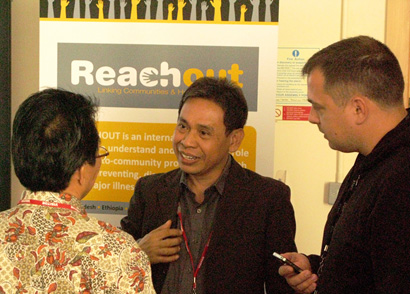 On the 23 May LSTM hosted the launch of REACHOUT, a consortium of eight partners supported by a 5 year EU FP7 grant, coordinated by LSTM. The consortium aims to maximize the equity, effectiveness and efficiency of close-to-community (CTC) health workers in preventing, diagnosing, and treating major health problems in rural areas and urban slums in Mozambique, Indonesia, Kenya, Malawi, Ethiopia and Bangladesh.
On the 23 May LSTM hosted the launch of REACHOUT, a consortium of eight partners supported by a 5 year EU FP7 grant, coordinated by LSTM. The consortium aims to maximize the equity, effectiveness and efficiency of close-to-community (CTC) health workers in preventing, diagnosing, and treating major health problems in rural areas and urban slums in Mozambique, Indonesia, Kenya, Malawi, Ethiopia and Bangladesh.
The launch was opened by Professor Janet Hemingway. Welcoming participants Dr Miriam Taegtmeyer, REACHOUT coordinator explained: “REACHOUT will generate a body of experienced competent researchers and institutions with experience in generating much-needed research on close to community providers”.
Who are close-to-community providers?
A CTC provider is a health worker who carries out promotional, preventive and/or curative health services and who is first point of contact at community level. A CTC provider can be based in the community or in a basic primary facility. CTC providers are being lauded by some sections of the global health community as a significant force for good in strengthening weak and dysfunctional health systems. CTCs are often volunteers and women carrying out their role in challenging circumstances. From an equity perspective REACHOUT could provide important insights into how their jobs could be improved, in terms of better support and greater efficiency, and highlight the value of their hard work.
A partnership for change
Dr Theobald, who is one of the Principle Investigators working on REACHOUT, introduced each of the consortium partners from the Royal Tropical Institute (KIT), Netherlands; Eijkman Institute, Indonesia; BRAC School of Public Health, Bangladesh; Sidama Health Zone/TB REACH, Ethiopia; University Eduardo Mondlane, Mozambique; Liverpool VCT, Kenya and the REACH Trust, Malawi.
Dr Rukhsana Ahmed, from the Eijkman Institute, said: “maternal health is a big issue in Indonesia and our job is to identify the gaps and find the best solutions.” While Korrie De Koning from KIT commented: “The shortage of human resources in health is important and the contribution of the close-to-community providers is close to our hearts.”
The first year of the project is a key moment to consolidate the systems and tools to manage and communicate the project to health system actors who have the power to make positive changes to the position of CTCs. LSTM will lead on finding ways of working which complement the processes and priorities of partners and that encourage learning and sharing across the consortium.
To close the meeting Dr Miriam Taegtmeyer thanked the partners for coming to LSTM and presenting on their aspirations for REACHOUT. Partners and invitees then had a chance to network and learn more about the project.

This project is funded by the European Union.
